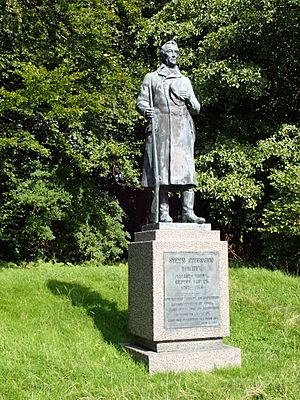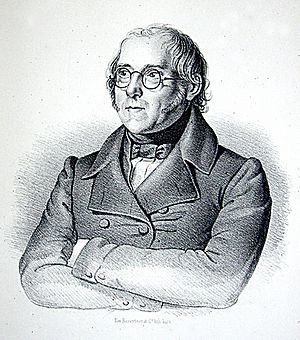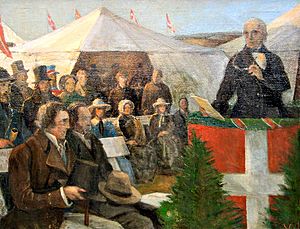Steen Steensen Blicher facts for kids
Steen Steensen Blicher (born October 11, 1782, died March 26, 1848) was a famous Danish writer and poet. He was born in a small town called Vium, near Viborg, in Denmark. Blicher is known for his stories and poems about the people and nature of his home region.
Contents
About His Life
Blicher's father was a parson (a type of priest) who loved books and writing. His family was even distantly related to Martin Luther, a famous historical figure.
Steen grew up close to nature and the simple life of farmers in the moor areas of central Jutland. He tried working as a teacher and a farmer. Later, he became a parson, just like his father. From 1825 to 1847, he worked in the parish of Spentrup.
As a clergyman, Blicher was more interested in hunting and writing than his church duties. He faced some challenges with his leaders during his career. He had ten children with his wife, Ernestine Juliane Berg, whom he married in 1810. They had seven sons and three daughters.
His Writing Style

Stories and Novels
Blicher is known for being a pioneer of the novella in Danish literature. A novella is a story that is longer than a short story but shorter than a novel. From the 1820s until he died, he wrote many tales. Most of these stories were about his home region in Jutland. He also wrote historical pieces and scientific sketches.
Many of his works were for entertainment, but about twenty to thirty of his stories are considered masterpieces. In his stories, Blicher often described the lives of people in Jutland. He is sometimes called a writer who focused on serious or sad topics, but he also had a lot of wit and humor.
Blicher was one of the first writers to use the idea of an unreliable narrator. This is when the person telling the story cannot always be trusted to tell the full truth. Here are some of his famous stories:
- The Diary of a Parish Clerk: This story, which made him famous, is about a poor farm boy's difficult life, including sad love, war, and being forced to leave his home.
- The Hosier and his Daughter: This classic story, made into a movie twice, describes a girl's mental struggles because of unhappy love.
- The Parson of Veilbye: This was the first Danish crime novel. It is told by a narrator who makes big mistakes, leading to someone being wrongly found guilty. This story has also been made into a movie.
- Tardy Awakening.
Blicher had other talents too. For example, E Bindstouw is a mix of stories and poems written in the Jutlandic dialect. It is similar to The Decameron, a famous collection of tales. In this work, Blicher shows his funny side.
Early critics admired Blicher's descriptions of nature, especially the moor landscape of Jutland and the people who lived there. These included the hardworking farmers and the "free" moor gypsies. Later, people also noticed his skill in writing about sad events and human feelings.
Blicher's writing style often switched between his own detailed, thoughtful way of telling a story and the everyday speech of farmers, landowners, and even robbers.
Poems
Blicher wrote poetry from the time of the Napoleonic Wars until his death. Some of his most important poems include:
- The thoughtful Til Glæden ("To Joy") from 1814.
- His local patriotic song "Kærest du Fødeland" (Dearest You Birthland), which shows his deep love for his home region.
- His impressive winter poem "Det er hvidt herude" (It is white out here), published in his well-known poetry collection "Trækfuglene" (Birds of Passage) in 1838.
The entire "Trækfuglene" collection was inspired by a serious illness he had. In these poems, he used different symbolic birds to express his own personal feelings and situation.
The cheerful dialect poem Jyden han æ stærk å sej ("The Jutlander he is strong and tough") was written in 1841. Many of Blicher's poems have been set to music later on. For example, "Det er hvidt herude" is often sung to a tune by Thomas Laub from 1914. Also, "Sig nærmer tiden, da jeg må væk" (The time approaches when I must go) is sung to a tune by Oluf Ring from 1922. Both of these are from "Trækfuglene".
His Ideas and Interests
Blicher was interested in many different things. He started out with more traditional views but later became a strong critic of society. He combined the ideas of an educated person from the 1700s with newer ideas of liberalism, which focuses on individual rights and freedoms. He tried to organize national celebrations in Jutland and suggested many new laws and changes. However, he was not fully accepted by the politicians of his time.
He also admired British culture and translated British poems, including Macpherson’s Ossian, and novels like Goldsmith’s The Vicar of Wakefield. He even tried writing poetry in English once.
Even though Blicher was part of the first Romantic generation of Danish writers, he was unique. He was more of a realist, writing about broken dreams and how time affects people. His religious views were based on older, more logical ideas.
He was influenced by the 18th-century English style of letter-writing novels. Also, his interest in local dialects and farmers made him a forerunner of regional writers who became popular around 1900, like Johannes V. Jensen.
How He Is Seen Today
Today, Blicher is seen as the person who started the Danish short story and regional writing. Many of his poems have been put to music, and his best stories have been printed many times.
Steen Steensen Blicher never became as famous worldwide as Hans Christian Andersen or Karen Blixen. However, in Denmark, he is almost as well-known. In 2006, his novel Præsten i Vejlbye was chosen for the Danish Culture Canon. This means it is officially one of the top 10 most important novels in Danish literature ever.
In Denmark, Blicher was famous and respected during his own lifetime. He has been praised for his contributions to Danish culture ever since. In 1951, experts who study literature started the Danish Blicher Society. Its goal is to "further and deepen the interest for Blichers life and writings." They do this through various activities. They have given out the Blicherprisen (The Blicher Prize) every year since 1955, and the society is still active today.
His Works
- Brudstykker af en Landsbydegns Dagbog (1824, novella, "Diary of a Parish Clerk")
- Sneklokken (1825, poetry, "The Snow Bell")
- Røverstuen (1827, novella, "The Robber’s Den")
- Ak! hvor forandret (1828, novella, "Alas how changed")
- Sildig Opvaagnen (1828, novella, "Tardy Awakening")
- Præsten i Vejlby (1829, novella, The Rector of Veilbye)
- Kjeltringliv (1829, novella, "Gypsy Life")
- Telse (1829, novella)
- Hosekræmmeren (1829, novella, "The Hosier and his Daughter")
- Trækfuglene (1838, poetry, "Birds of Passage")
- De tre Helligaftener (1841 and 1846, novella, "Three Holliday Eves")
- E Bindstouw, Fortællinger og Digte i jydske Mundarter (1842, novella-poetry, dialect)
Blicher's Works in English
- The Diary of a Parish Clerk and Other Stories. Pref. by Erik Harbo, introd. by Margaret Drabble, transl. by Paula Hostrup-Jessen. Athlone Press (1996) ISBN: 0-485-11500-X
- Tardy Awakening and Other Stories, ed. with afterword and comment. by Niels Ingwersen, transl. by Paula Brugge & Faith Ingwersen. University of Wisconsin (WITS II vol.#7, 1996).
See also
 In Spanish: Steen Steensen Blicher para niños
In Spanish: Steen Steensen Blicher para niños



